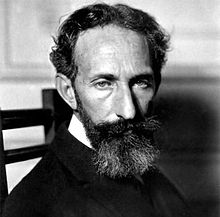Horacio Quiroga
| Horacio Quiroga | |
|---|---|
 |
|
| Born |
December 31, 1878 Salto, Uruguay |
| Died | February 19, 1937 (aged 58) Buenos Aires, Argentina |
| Nationality | Uruguayan |
| Spouse(s) | Ana María Cires (1909-1915), María Elena Bravo (1927-1934) |
| Children | Eglé Quiroga (1911), Darío Quiroga (1912), María Elena Quiroga (1928) |
Horacio Silvestre Quiroga Forteza (31 December 1878 – 19 February 1937) was a Uruguayan playwright, poet, and short story writer.
He wrote stories which, in their jungle settings, use the supernatural and the bizarre to show the struggle of man and animal to survive. He also excelled in portraying mental illness and hallucinatory states. His influence can be seen in the Latin American magic realism of Gabriel García Márquez and the postmodern surrealism of Julio Cortázar.
Horacio Quiroga was born in 1878 as the sixth child and second son of Prudencio Quiroga and Pastora Forteza, a middle-class family. At the time of his birth, his father worked for 18 years as head of the Vice-Consulate Argentine Break. Before Quiroga was two and a half months old, on March 14 of 1879 his father accidentally fired a gun he carried in his hand and died. Quiroga was baptized just about three months later in the parish of his birth town.
Quiroga finished school in Montevideo, the capital of Uruguay. He studied at the National College and also attended Polytechnic Institute of Montevideo for technical training. He demonstrated enormous interest in a variety of subjects, such as literature, chemistry, photography, mechanics, cycling and country life. He founded the Cycling Society of Salto and achieved the remarkable feat of uniting bicycle cities of Salto and Paysandu (120 km).
During this time, he worked in a repair shop and it was under the influence of the owner's son that he became interested in philosophy. He described the man as a, "frank and passionate soldier of materialistic philosophy."
When he was 22, Quiroga put out his poetic feelers and discovered the poetry of Leopoldo Lugones and Edgar Allan Poe (he would eventually become great friends with Lugones). The discovery of these authors moved him to dabble in various schools and styles: post-romanticism, symbolism and modernism. Armed with this background, he soon began to publish his poems in his hometown. As he continued studying, working with publications and Reform Magazine he improved his style and became well-known.
...
Wikipedia
